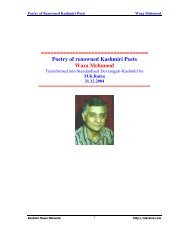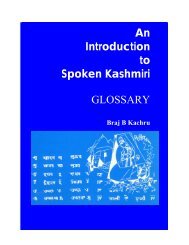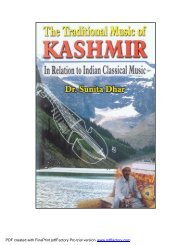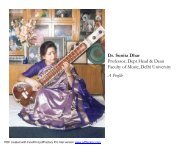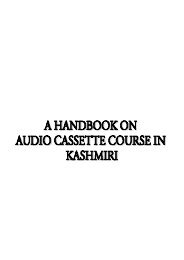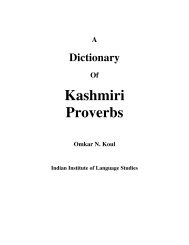Introductory Pages - An Introduction to Spoken Kashmiri
Introductory Pages - An Introduction to Spoken Kashmiri
Introductory Pages - An Introduction to Spoken Kashmiri
Create successful ePaper yourself
Turn your PDF publications into a flip-book with our unique Google optimized e-Paper software.
<strong>An</strong> <strong>Introduction</strong> <strong>to</strong> <strong>Spoken</strong> <strong>Kashmiri</strong><br />
by Braj B. Kachru<br />
3. Siraji : This is spoken in the <strong>to</strong>wn of Doda on the River Chinab. Whether or not it is a<br />
dialect of <strong>Kashmiri</strong> is still debated. Grierson thinks that it can, with almost “equal<br />
correctness, be classed as a dialect of <strong>Kashmiri</strong>... because it possesses certain Dardic<br />
characteristics which are absent in Western Pahari. [11]<br />
4. Rāmbani: This is spoken in a small area that lies between Srinagar and Jammu. It is a<br />
mixture of Siraji and Dogri, and shares features with both <strong>Kashmiri</strong> and Dogri.<br />
In the literature, the <strong>Kashmiri</strong> Speech Community has traditionally been divided in<strong>to</strong> the<br />
following area-defined dialects:<br />
(a) mara:z (in the southern and southeastern region),<br />
(b) kamra:z (in the northern and northwestern region), and<br />
(c) yamra:z (in Srinagar and some of its surrounding areas).<br />
On the basis of this grouping, it is believed that the <strong>Kashmiri</strong> spoken in the mara:z area is highly<br />
Sanskritized and the variety spoken in the kamra:z area has had a deep Dardic influence. Note<br />
that further research on the dialect situation of <strong>Kashmiri</strong> may show that, in addition <strong>to</strong> village<br />
dialects (and perhaps religious dialects), Kashtawari is the only dialect of <strong>Kashmiri</strong> outside of the<br />
valley, and that the other dialects discussed above are only partially influenced by <strong>Kashmiri</strong>,<br />
since they are spoken in transition zones.<br />
Sanskritized and Persianized Dialects<br />
In earlier and current literature, it has been claimed that in terms of the users there are two<br />
dialects of <strong>Kashmiri</strong>: Hindu <strong>Kashmiri</strong>, and Muslim <strong>Kashmiri</strong> [12] The evidence presented for<br />
this religious dicho<strong>to</strong>my is that Hindu <strong>Kashmiri</strong> has borrowings from Sanskrit sources, and<br />
Muslim Kashimri has borrowings from Persian (and Arabic) sources. It turns out that the<br />
situation is not as clear cut as has been presented by Grierson and Zinda Koul ‘Masterji’, for<br />
example. The religious dicho<strong>to</strong>my applies, <strong>to</strong> some extent, <strong>to</strong> Srinagar <strong>Kashmiri</strong>, but it presents<br />
an erroneous picture of the overall dialect situation of the language. We shall, therefore, use<br />
rather neutral terms, i.e., Sanskritized <strong>Kashmiri</strong> (SK) and Persianized <strong>Kashmiri</strong> (PK).<br />
The differences at the phonetic/phonological levels between the two communities may be<br />
explained in terms of distribution and frequency of certain phonemes. The sub-system of<br />
borrowed phonological features also is shared by the educated speakers of the two communities<br />
(e.g., /f/ and /q/). The other differences are mainly lexical and, in a very few cases,<br />
morphological. Lexically, SK has borrowed from Sanskrit sources and PK from Persian and<br />
Arabic sources. This aspect of <strong>Kashmiri</strong>, however, needs further research.<br />
In village <strong>Kashmiri</strong>, the religion-marking phonetic/phonological and morphological features<br />
merge in<strong>to</strong> one, though in Srinagar <strong>Kashmiri</strong>, as stated earlier, they mark the two communities as<br />
separate. In recent years, with the spread of education, the religious differences have been slowly<br />
disappearing. In earlier studies, the observations made on the religious dialects of <strong>Kashmiri</strong> are<br />
mainly based on lexical evidence, and whatever phonetic/phonblogical evidence is presented is<br />
from Srinagar <strong>Kashmiri</strong>. Consider, for example, the sound alternations in the following section.<br />
© 2006 Braj B. Kachru (http://kachru.com) 4<br />
http://koshur.org/<strong>Spoken</strong><strong>Kashmiri</strong>



